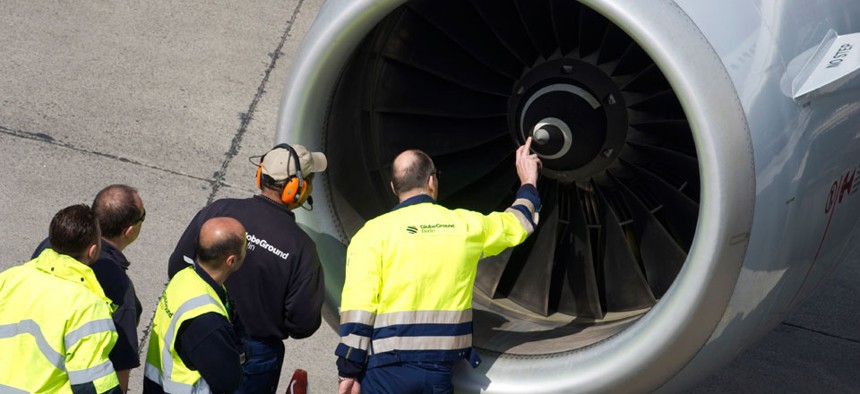What Happens if a Drone Gets Sucked Into a Passenger Jet Engine

Members of ground staff inspect an engine of a Lufthansa aircraft at Tegel airport in Berlin. Gero Breloer/AP File Photo
Last week’s near-collision between a hobby drone and a passenger aircraft portends what could happen as the sky gets a lot more crowded.
Last week’s near-collision between a hobby drone and a passenger aircraft portends what could happen as the sky gets a lot more crowded. And the nightmare scenario that has people concerned about drones is that one of them flies too close to a passenger jet and gets sucked into an engine.
Pilots deal with similar collisions with some frequency already—except they involve birds. And the outcome can be for the affected engine to die in midair.
Bird strikes are such a big problem in aviation that there are annual bird-strike conferences and several countries with bird-strike task forces. It was a collision with a flock of birds that caused the problems leading to 2009′s “Miracle on the Hudson” emergency landing in the New York area. And the phenomenon even has its own awesome acronym: BASH, which stands for Bird Aircraft Strike Hazard. (The industry term for gooey bird remains in an engine is also amusing: snarge.)
This video shows what is likely a real-life bird strike:
And this video shows a test scenario where an engine tears itself apart after a foreign object is thrown into it: (the action starts about 17 seconds in):
Robert Harwood, the aviation director for Ansys, a company that develops simulations for aircraft emergencies, says that a drone getting sucked into an engine would probably be a lot like a bird strike. “Except obviously, with a drone it’s probably metallic or plastic, so it’s going to be more substantial than something fleshy.”
In a jet engine there are several concentric rings of high-speed fan blades that simultaneously push air backwards and compress it for combustion. An object such as a bird or drone that enters the intake dislodges the blades from their ring, bending or breaking them and seizing their rotation. This causes what’s known as catastrophic engine failure.
This is bad, because that engine is dead.
Most passenger jets have two or four engines, and can fly with one or more disabled. The most likely times for any drone collisions are around takeoff and landing—because planes are at lower altitudes then—which increases the chances of a successful emergency landing if needed.
Regulator-mandated engine specifications help ensure that any explosions and debris from a drone collision would be contained. Regulators such as the US Federal Aviation Administration even go so far as to require that all aircraft engines undergo tests involving launching dead birds (or something of equivalent weight) into the engines to make sure the damage is localized. “The engines themselves are designed so if the blades break the shroud will prevent it from piercing and going into the cabin,” says Harwood.
With drones, he says, “if it’s a bigger drone and moving more quickly, it changes the equation.” There’s could also be an added danger of combustion in gas-powered drones. But just how much any of this is different from a bird collision we don’t yet know conclusively. The FAA isn’t making anyone launch drones into engines as part of their turbine intake collision tests, according to an agency representative.
The FAA is currently conducting trials for new rules that would open the skies both for hobbyists, and commercial ventures like Amazon’s planned drone courier service. Assuming regulation is rolled out, the main danger to airplanes would be rogue hobbyist drone operators who fly their drones in takeoff or landing zones.
Even with rogue hobbyists, Harwood says that drone collisions are not a huge area of concern for the aviation community. He sees the risk of mid-air collisions as statistically very low.
Reprinted with permission from Quartz. The original story can be found here.
NEXT STORY: Remember the VA Replacement Scheduling Project?






